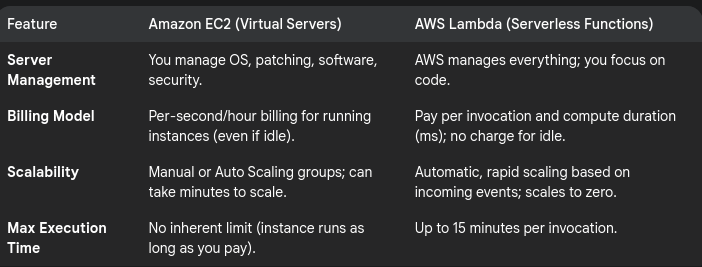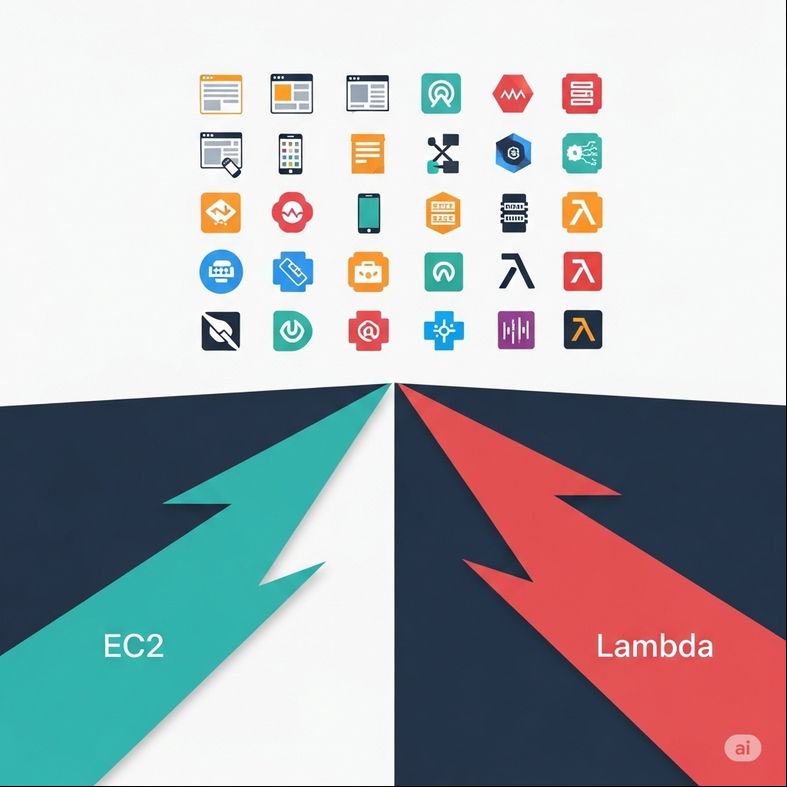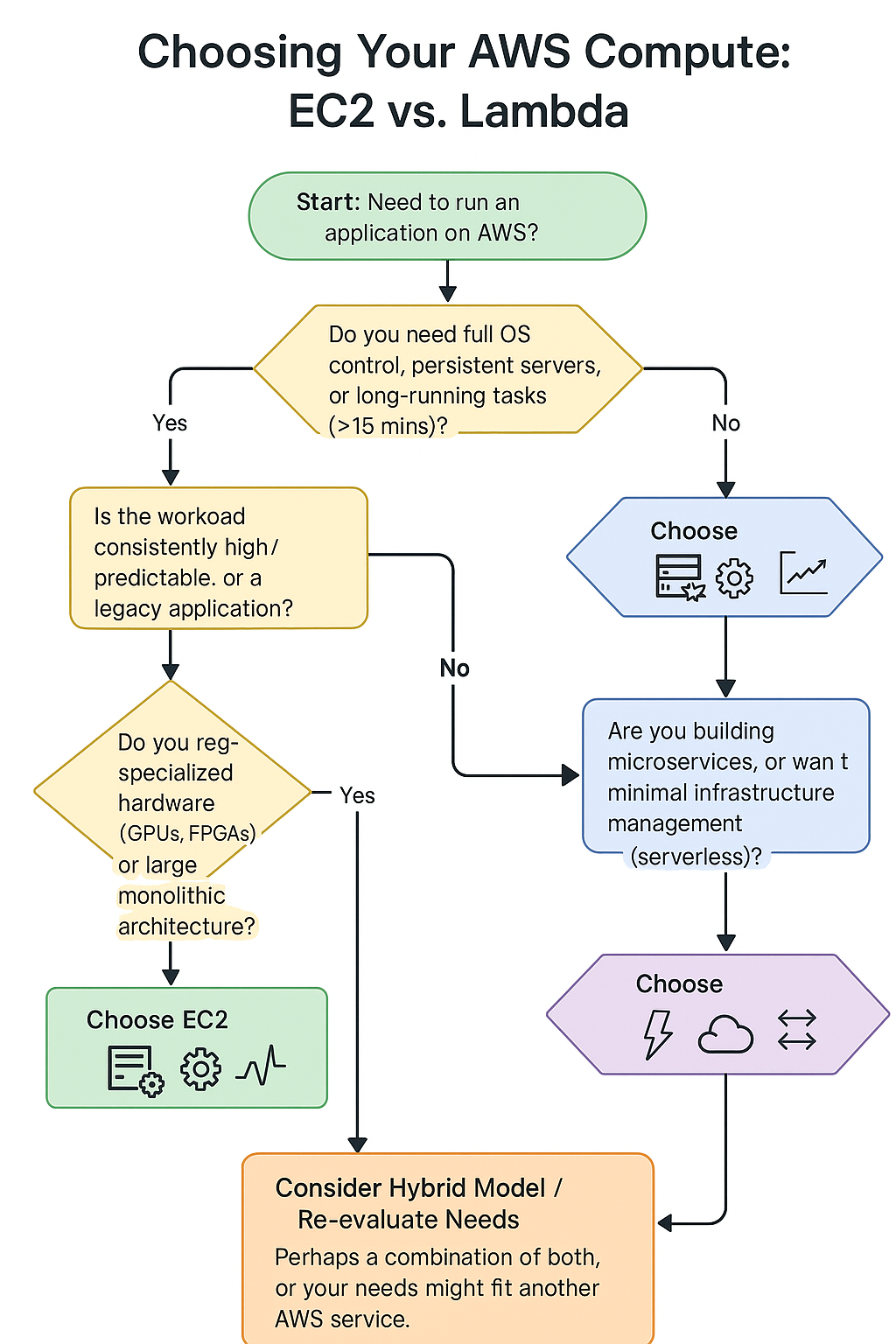Like most decisions in AWS cloud computing, choosing the right engine for your applications is non-trivial. EC2 vs Lambda, the heavyweights in the arena, are seldom in dispute: Amazon EC2 (Elastic Compute Cloud) and AWS Lambda. Both have provisions to run your code; however, their approaches, operational models, and cost structures are drastically different. One wrong move could mean blowing money, experiencing severe performance issues, or dealing with operational chaos.
If these concerns resonate with you, here are the questions you might be asking yourself:
- “Is it vital for me to have complete control over my server environment, or can I utilize serverless technology?”
- “Against my specific workload, which service is cheaper: EC2 vs Lambda?”
- “Performance and scalability: Which is superior on Lambda or EC2?”
This isn’t just a technical differences document; it’s a metaphorical roadmap. We’ll deep dive into Lambda and EC2 so you can understand the crucial factors that decide each of them, helping you figure out the AWS compute service that best matches your application needs, budget, and working style.
Knowing the Competitors: What is EC2? What is Lambda?
Before getting into the EC2 vs Lambda, let’s quickly introduce our contenders:
Amazon EC2 (Elastic Compute Cloud): Your Virtual Server in the Cloud
Imagine you’re renting virtual servers (instances) from AWS’s data centers. That’s EC2.
- Full Control: Select the operating system (Linux, Windows), instance type (CPU/memory/storage/networking capacity), and any software you want to install.
- Persistent Infrastructure: Instances run nonstop (unless you stop/terminate them) and have persistent storage (EBS volumes).
- You Manage (Mostly): You take care of OS patching, security configurations, software updates, and most likely scaling (though Auto Scaling makes this easier). AWS manages the hardware.
AWS Lambda: Your Event-Driven, Serverless Function Executor
With Lambda, you can run code without having to procure or handle server resources.
- Serverless: Complete management of infrastructure – OS, patching, scaling, availability – is in AWS’s hands. All you have to do is upload your “function” (your code).
- Event-Driven: Triggers for Lambda functions include: an HTTP request via API Gateway, a new file uploaded into S3, a message in SQS, a schedule, etc.
- Ephemeral & Stateless (by default): Functions start due to an event, run for a predetermined amount of time, and then are deleted. They don’t normally have state across calls (although stateful implementations are possible).
- Pay Per Execution & Duration: Payment is only for the amount of requests your functions handle and the amount of time (in milliseconds) allocated to the computing resources.
The Core Showdown: EC2 vs Lambda – Key Differentiating Factors

When to Pick Amazon EC2: Control, Agility, and Predictable Mileage
Control and flexibility still make EC2 the backbone of a variety of workloads. Go for EC2 when considering EC2 vs Lambda:
- You Need Entire Indefeasible Control:
- Deep OS configuration steps require specific software, operating system package installation, or custom business software needs.
- Control over applications bound by certain kernel dependencies or proprietary software licenses tied to a specific operating system.
- Running Persistent or Long Duration Processes:
- Batch jobs that take hours or days to execute.
- Applications that require long-lasting in-memory state or deep connection introspection.
- Databases (though services like RDS are often the preferred option).
- Legacy Applications:
- Migrating existing on-premise applications (“lift and shift”) without redesigning them towards serverless architecture.
- Big, Monolithic Applications:
- Applications that are complex to decompose into numerous smaller applications.
- Unique Hardware Specifications:
- Needing GPUs, FPGAs, High Memory, or Extreme CPU/networking capacity enabled instances unsuited for fleeting functions.
- Workloads With Long Duration Predictability Factors:
- If your application witnesses continuously high traffic, using Reserved Instances or Savings Plans on EC2 offers more value compared to Lambda’s request-based pricing for sustained high load.
When to Pick AWS Lambda: Auto-Scaling, High Control, Imposed Budget, and Low Demand

Event-driven architecture with fluctuating workflow is perfect for Lambda. Use Lambda when making your choice between EC2 vs Lambda:
- Developing Microservices & Event-Driven Architectures:
- Responding to S3 events, Kinesis data streams, API Gateways, DynamoDB streams, IoT messages, and any other event.
- Creating and deploying small independent microservices that are capable of autonomous scaling.
- Optimized Over-Under Traffic Spending:
- With low or highly sporadic traffic, your application is ideal for Lambda’s per-usage pricing.
- Excelling under demanding automatic scaling:
- Lambda only works on demand and almost instantly responds to changes in demand in scaling, with no prior warming or planning (beyond concurrency limits) required. Not in use? Scales down to zero.
- Serving Code and Not Infrastructure:
- Remote server monitoring, patching, and OS security constitute minimal operational overhead for you.
- Operated on stateful, short tasks with a defined lifetime like real-time analytics snippets, scheduled pseudo-cron jobs, data transformation, and image processing upon upload.
- Appliance and Web Program APIs & Backend:
- Creating powerful and widely accepted patterns by using API Gateway and Lambda for the construction of RESTful APIs.
Latency, Throughput, and Cold Starts: Performance Under Extra Scrutiny in EC2 vs Lambda
EC2 Performance:
- Consistent Predictability: Once an instance has been designated, its performance will increase depending on the type.
- Latency: As there’s no invocation overhead, applications running on the instance experience low latency.
- Throughput: The size and capacity of the instance dictate throughput, alongside the network capacity and application efficiency. More can be added by incorporating additional instances.
Lambda Performance:
- Cold Starts: For some latency-sensitive applications, “cold starts” can slow down a function for its first use. If idle for a while, a cold start occurs, which will put strain on resources needing initialization (downloading code, starting the runtime). This can lead to hundreds of milliseconds or even seconds of added latency.
- Amortization: Specified environments can be kept warm, alongside optimizing function size, trimming dependencies, and choosing faster runtimes such as Go and Rust rather than Java and .NET in some situations.
- Warm starts: Means that invoking an environment that has already warmed up can lead to outright instant speed.
- Throughput: The unit for Lambda is defined to the level of concurrent requests it can handle before scaling out horizontally. The only limitation are concurrency checks tied to free account resources that can be expanded.
Cost Modifiers: Beyond the Per-Second or Invocation Price Tag EC2 vs. Lambda

Specifically, when comparing operational fees, consider additional storage costs and managing team time used for servicing an instance:
EC2 Costs:
EC2 costs don’t define a straightforward tier base; however, they outline:
- Time running an instance with defined activities puts operational sets such as EBS managing data transfer, which are calculated by seconds and hours spent deploying and integrating, together with potential upkeep costs from FuelClaim and LoadBalance.
- In terms of saving resources, Reserved Instances, Savings Plans, and Spot Instances allow for greater efficiency when it comes to specific workloads.
Expenses with Lambda:
- Number of requests ($X per 1 million requests).
- Compute Duration (GB-seconds).
- Cost of Data Transfer.
- Costs from API Gateway, SQS, or any other triggering service may be included.
- Free Tier: Is very generous regarding the number of requests and compute time.
- Cost-effective for low or sporadic traffic: When Lambda runs infrequently, it is typically almost always cheaper.
- Can become expensive with very high and sustained throughput: If there’s constant high traffic, the per-request model could outweigh the value of having an EC2 fleet provisioned.
Pro Tip: Use the AWS Pricing Calculator together with proof-of-concept tests to estimate for your specific workload patterns. Don’t forget, consider the Total Cost of Ownership (TCO), including operational overhead for both EC2 vs Lambda.
Strategic Scenarios: Making the Right Choice for EC2 vs Lambda
Let’s look at some common application types and see which compute service fits best:
- Monolithic Web Application:
- Likely EC2: Simpler “lift and shift” and gradually refactor into Lambda/microservices over time if so desired.
- New REST API Backend for Mobile App:
- Likely Lambda (with API Gateway): Low operational overhead and high scalability are excellent attributes for fluctuating mobile traffic.
- Daily Batch Data Processing Job (runs for two hours):
- AWS Batch (on EC2) or EC2 Spot Instance: If it must run for two hours straight, EC2 is suitable, and Spot Instances are very cheap.
- Lambda (if breakable): If the job can be divided into smaller tasks that take less than 15 minutes and can be triggered by SQS/Step Functions, then Lambda is a viable option.
- Real-Time Image Resizing on S3 Upload:
- Definitely Lambda: Another classic event-driven use case which is serverless. Cost-efficient and scales seamlessly.
- High Performance Computing (HPC) Or ML Training:
- Likely EC2 (with specialized P3 or G4 instances): These high-demand, long-duration, and custom hardware tasks are not designed for Lambda.
Final Thoughts: EC2 vs Lambda – The Right Tool for the Job
It isn’t about the “better” service. The debate on EC2 vs Lambda builds around which service better suits your needs.
- Use EC2: When control is required, along with running stateful, long-running tasks, or when needing to migrate legacy applications.
- Use AWS Lambda: When dealing with event-driven architectures, microservices, or burst-y workloads, where cost-effectiveness is critical, and when you want to reduce infrastructure oversights.
Often the best architectures make use of a hybrid model, using EC2 for stable, long-running components and Lambda for dynamic, event-driven parts of the system. It’s important to grasp fundamental trade-offs in management, cost, scalability, and performance to create efficient, reliable, and economical solutions on AWS for EC2 vs Lambda.
Unlock AWS Savings Overview
➡️ See Costq.ai In Action: Request Your Personalized Demo Today!
➡️ Unlock Exclusive AWS Savings: Explore Costq.ai Features & Group Buying!
FAQs: EC2 vs Lambda Frequently Asked Questions
Q1: Is it feasible for Lambda to fully substitute EC2?
A: No, not for every workload. Lambda is an excellent choice for short-lived functions triggered by events. For mission-critical workloads operating 24/7, applications needing deep OS control, stateful applications that cannot employ an external state management system readily, and tasks needing dedicated hardware (GPUs, for instance), EC2 is indispensable. The choice between EC2 vs Lambda depends on the specific needs of your application.
Q2: Is it true that Lambda is always less expensive than EC2?
A: Not necessarily. If traffic is exceptionally low or sporadic, Lambda almost always wins because of its pay-per-execution model and free tier. Yet with consistently high traffic, bustling schedules, and predictability, a fleet of EC2 instances adopted with Reserved Instances or Savings Plans may deliver savings compared to the per-request metered pricing for Lambda at scale. This highlights a key cost consideration in the EC2 vs Lambda comparison.
Q3: How do I manage the state in AWS Lambda’s services since it’s stateless?
A: To manage state, you leverage other AWS services:
- Amazon DynamoDB – for swift, scalable NoSQL key-value storage.
- Amazon S3 – for object storage.
- Amazon ElastiCache – for caching data in memory.
- Amazon RDS – for maintaining relational databases, though the numerous connections from multiple Lambdas in parallel can be difficult to manage, typically using an RDS Proxy.
Q4: What about “cold starts” with Lambda? Are they a deal-breaker?
A: Cold starts can be a concern for ultra-latency-sensitive applications. However, AWS has made significant improvements, and features like Provisioned Concurrency can mitigate them by keeping functions warm. For many applications, occasional cold start latency is acceptable, especially given Lambda’s other benefits. This is a common performance point when discussing EC2 vs Lambda.
Q5: Can I run containers on Lambda?
A: Yes! AWS Lambda now supports packaging and deploying functions as container images (up to 10GB in size). This allows you to use familiar container tooling and include larger dependencies. This blurs the lines slightly with services like Fargate but still adheres to Lambda’s event-driven, short-execution model.
Q6: How do I choose between Lambda and AWS Fargate (serverless containers)?
A:
- Lambda: Best for short-lived functions (<15 mins), highly event-driven, when you don’t want to think about containers at all (unless using container image support).
- Fargate (with ECS or EKS): Better for longer-running containerized applications, when you need more control over the container environment, or when migrating existing containerized apps that don’t fit Lambda’s model. Fargate is serverless for the infrastructure but you still manage the container definition and task.
These Blogs May Be Helpful for You.
